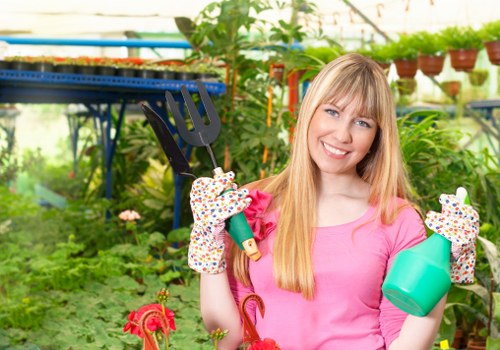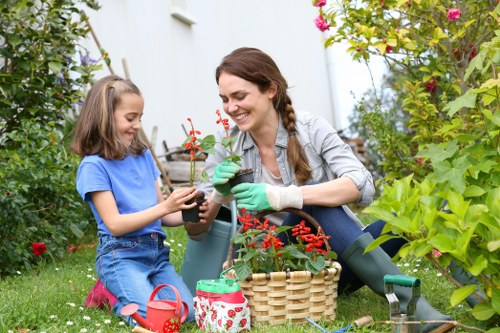Transforming Urban Spaces: Landscape Gardening in Covent Garden
Welcome to Covent Garden's Green Oasis

Covent Garden, a vibrant heart of London, is not just famed for its rich history and bustling markets but also for its enchanting green spaces. Landscape gardening in Covent Garden plays a pivotal role in maintaining the area's charm, offering both locals and visitors serene retreats amidst the urban hustle.
With its blend of historic architecture and contemporary flair, Covent Garden presents a unique canvas for landscape gardeners. The challenge lies in harmonizing the old with the new, creating gardens that complement the surrounding structures while introducing elements of nature that uplift the spirit.
Whether it's a small courtyard garden or a larger public space, the principles of landscape gardening in Covent Garden focus on sustainability, aesthetics, and functionality. This ensures that green spaces are not only beautiful but also beneficial to the community and the environment.
Design Principles for Effective Landscape Gardening

1. Sustainability and Eco-Friendliness
In today's world, sustainable practices are paramount. Landscape gardening in Covent Garden emphasizes the use of native plants that require less water and are more resistant to local pests, reducing the need for chemical interventions.
Implementing rainwater harvesting systems and incorporating composting areas are common practices. These not only minimize water usage but also promote recycling of organic waste, contributing to a healthier ecosystem.
Moreover, selecting drought-resistant plants helps in maintaining greenery even during dry spells, ensuring that gardens remain lush and vibrant throughout the year.
2. Aesthetic Harmony
Creating visually appealing gardens involves careful selection of plants, colors, and textures. Landscape gardeners in Covent Garden often blend flowering plants with evergreen varieties to ensure year-round interest.
The use of ornamental features such as fountains, sculptures, and garden lighting adds depth and character to the space. These elements serve as focal points, drawing the eye and enhancing the overall design.
Color coordination is also crucial. Choosing complementary colors can create a harmonious and inviting atmosphere, making the garden a perfect spot for relaxation and social gatherings.
3. Functionality and Accessibility
A well-designed garden is not only beautiful but also functional. Pathways are laid out to facilitate easy movement, while seating areas are strategically placed for comfort and convenience.
Incorporating elements like pergolas and gazebos provides shaded areas, making the garden enjoyable even during sunny days. Additionally, ensuring accessibility for all, including those with mobility challenges, is a key consideration.
Functional spaces within the garden, such as vegetable patches or herb gardens, encourage community involvement and provide practical benefits, supporting urban agriculture initiatives.
Choosing the Right Plants for Covent Garden

Native vs. Exotic Plants
Choosing the right plants is fundamental to successful landscape gardening. Native plants are often preferred in Covent Garden due to their adaptability to the local climate and soil conditions.
They require less maintenance and are more resilient against local pests and diseases, making them a sustainable choice for urban gardens.
However, incorporating exotic plants can add unique textures and colors, creating visually striking gardens. The key is to balance native and exotic species to ensure both beauty and sustainability.
Seasonal Planting Strategies
Covent Garden experiences a temperate climate, allowing for a diverse range of plants. Seasonal planting ensures that gardens remain vibrant throughout the year.
Spring blooms like tulips and daffodils herald the start of the gardening season, while summer plants such as roses and lavender add warmth and color. Autumn foliage and winter evergreens maintain structure and interest during the colder months.
By planning for each season, landscape gardeners can create dynamic gardens that evolve and change, providing continuous enjoyment.
Herbs and Edible Gardens
Integrating edible plants into landscape designs is a growing trend. Herbs like basil, mint, and rosemary not only add fragrance but also offer culinary benefits.
Vegetable gardens, though compact, can thrive in urban settings with the right planning. Raised beds and vertical planting techniques maximize space, allowing for productive and aesthetically pleasing gardens.
Edible gardens promote sustainability and offer a tangible connection between urban dwellers and their food sources, enhancing the overall gardening experience.
Innovative Landscape Gardening Techniques

Vertical Gardening
Space constraints in Covent Garden make vertical gardening an attractive option. Utilizing walls, fences, and trellises allows for the cultivation of plants in vertical spaces, optimizing limited areas.
Vertical gardens can be both functional and decorative, providing greenery without encroaching on valuable ground space. They also offer opportunities for creative plant arrangements and patterns.
This technique not only enhances the aesthetic appeal but also improves air quality and provides insulation, contributing to a more sustainable urban environment.
Green Roofing
Green roofs are an innovative solution for adding greenery to buildings without sacrificing ground space. By planting vegetation on rooftops, landscape gardeners can create lush, green spaces that offer environmental benefits.
Green roofs help in reducing urban heat islands, managing stormwater runoff, and improving building insulation. They also provide aesthetic value and can be designed to include seating areas or recreational spaces.
In Covent Garden, green roofs contribute to the area's sustainability goals while enhancing the visual appeal of buildings from above.
Rain Gardens and Water Management
Effective water management is crucial in landscape gardening. Rain gardens are designed to capture and absorb rainwater, reducing runoff and preventing waterlogging.
These gardens are planted with water-tolerant species that thrive in moist conditions, creating beautiful and functional landscapes. They also support local wildlife by providing habitats for beneficial insects and birds.
Incorporating rain gardens into Covent Garden's landscape designs promotes environmental stewardship and enhances the resilience of urban green spaces.
Maintenance Practices for Thriving Gardens

Regular Pruning and Trimming
Maintaining plant health and garden aesthetics requires regular pruning and trimming. This practice helps in shaping plants, promoting healthy growth, and preventing overgrowth that can lead to disease.
Proper pruning techniques vary depending on the plant species, ensuring that each plant is cared for appropriately to maintain its natural form and vigor.
Scheduled maintenance not only keeps the garden looking pristine but also encourages the longevity of plants, ensuring sustained beauty over time.
Soil Health and Fertilization
Healthy soil is the foundation of a thriving garden. Regularly testing soil pH and nutrient levels ensures that plants receive the necessary nutrients for optimal growth.
Using organic fertilizers and compost enriches the soil, enhancing its structure and fertility. This promotes robust plant growth and reduces the reliance on chemical fertilizers.
Mulching is another important practice that conserves moisture, suppresses weeds, and adds organic matter to the soil, further enhancing its health and fertility.
Integrated Pest Management
Protecting plants from pests and diseases is essential for a healthy garden. Integrated Pest Management (IPM) focuses on using environmentally friendly methods to control pest populations.
Encouraging beneficial insects, such as ladybugs and bees, helps in naturally managing pests without the need for harmful chemicals.
Regular monitoring and early detection of pest issues allow for prompt and effective interventions, maintaining the garden's health and beauty.
Community and Educational Initiatives

Community Gardens
Community gardens in Covent Garden foster a sense of community and provide opportunities for residents to engage in gardening activities. These shared spaces encourage collaboration, learning, and social interaction.
By participating in community gardening, individuals can gain hands-on experience in landscape gardening, contributing to personal growth and community development.
These gardens also serve as educational hubs, teaching sustainable gardening practices and promoting environmental awareness.
Workshops and Educational Programs
Landscape gardening in Covent Garden is complemented by a variety of workshops and educational programs. These initiatives educate enthusiasts on best practices, new techniques, and the importance of sustainable gardening.
Topics range from composting and rainwater harvesting to advanced landscape design and plant biology, catering to both beginners and seasoned gardeners.
Educational programs also highlight the cultural and historical significance of Covent Garden's green spaces, fostering a deeper appreciation for the area's natural heritage.
Collaborations with Local Organizations
Collaborating with local organizations enhances the impact of landscape gardening initiatives. Partnerships with schools, environmental groups, and cultural institutions promote widespread engagement and resource sharing.
These collaborations facilitate large-scale projects, such as urban greening campaigns and habitat restoration efforts, amplifying the benefits of landscape gardening across Covent Garden.
Working together with diverse stakeholders ensures that gardening projects are inclusive, sustainable, and aligned with the community's needs and values.
Future Trends in Landscape Gardening

Smart Gardening Technologies
The integration of technology in landscape gardening is an emerging trend. Smart irrigation systems, automated lighting, and sensor-based monitoring enhance garden maintenance efficiency.
These technologies not only save time and resources but also ensure that gardens receive optimal care, adapting to changing environmental conditions in real-time.
In Covent Garden, the adoption of smart gardening solutions aligns with the area's innovative spirit, paving the way for futuristic urban green spaces.
Biophilic Design
Biophilic design emphasizes the connection between humans and nature, incorporating natural elements into urban environments. This approach enhances mental well-being and promotes a sense of tranquility.
Features such as living walls, natural lighting, and organic materials are central to biophilic landscape gardening, creating immersive natural experiences within the city.
Implementing biophilic design in Covent Garden adds a layer of serenity and beauty, making urban living more harmonious and sustainable.
Climate-Resilient Gardens
With the growing impact of climate change, landscape gardening must adapt to create resilient green spaces. This involves selecting climate-resistant plants and designing gardens that can withstand extreme weather conditions.
Strategies include creating microclimates within gardens, utilizing drought-tolerant species, and implementing systems for efficient water management.
Climate-resilient gardens in Covent Garden ensure that green spaces remain functional and beautiful, even in the face of environmental challenges.
Conclusion: Embracing Green Living in Covent Garden

Landscape gardening in Covent Garden is a testament to the harmonious blend of tradition and innovation. By prioritizing sustainability, aesthetics, and community engagement, gardeners are transforming urban spaces into green sanctuaries.
As Covent Garden continues to evolve, its green spaces will play a crucial role in enhancing the quality of life, promoting environmental stewardship, and fostering a connected community.
Whether you are a seasoned gardener or a curious enthusiast, landscape gardening in Covent Garden offers endless opportunities to contribute to and enjoy the area's lush, thriving environment.
Contact us today to explore how you can become a part of Covent Garden's green transformation or book your service now to create your own urban oasis.